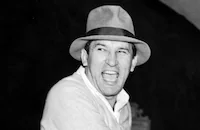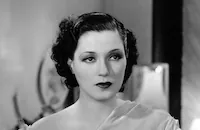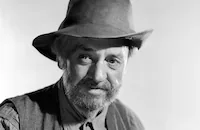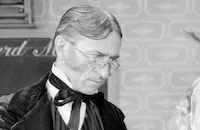Satan Met a Lady

Brief Synopsis
Cast & Crew
William Dieterle
Bette Davis
Warren William
Alison Skipworth
Arthur Treacher
Marie Wilson
Film Details
Technical Specs

Synopsis
Private detective Ted Shane returns to his old partner Ames after he is forced to leave another town. Ames is not happy to see Shane because he and Mrs. Ames were in love before she married Ames. Shane brings business into the agency, however, and one of their new clients is Valerie Purvis, who asks for help finding a man who jilted her. Ames follows her to a meeting with a man whom she hopes will lead her to her former lover. The next day both Ames and Farrow, the man he was following, are dead and Shane is the primary suspect. At Valerie's hotel, Shane demands the true story from her and she forces him out at gunpoint. When he gets home, Shane finds his apartment and his office have been ransacked, and his secretary, Miss Murgatroyd, has been locked in the closet. This is all the work of Anthony Travers, an Englishman on the trail of Roland's trumpet, an instrument which is rumoured to be filled with jewels. Shane suspects that Valerie is also searching for the horn, but she denies it. Madame Barabbas, a notorious criminal, sends a gunman to bring Shane to her. She, too, is looking for the trumpet. Shane takes money from all of them to find the horn, then receives a message to visit a recently docked ship. When he arrives at the docks, the ship is in flames and Valerie, Travers and Madame Barabbas are watching. In the confusion, Shane acquires the package containing the horn, which was transported on the destroyed ship, but when he opens it up, sand pours out instead of jewels. The police round up all the criminals except Valerie. Shane escapes with her to the train, but before the next station, he accuses her of Ames' murder and delivers her to the waiting police when the train stops. Miss Murgatroyd is waiting for him and they leave together.

Director

William Dieterle
Cast

Bette Davis

Warren William

Alison Skipworth

Arthur Treacher

Marie Wilson

Winifred Shaw

Porter Hall

Olin Howland
Charles Wilson
Maynard Holmes
Barbara Blane
James Burtis
Frank Darien
Crew

Videos
Movie Clip



Trailer
Film Details
Technical Specs

Articles
Satan Met a Lady
Satan Met a Lady is a rather loopy adaptation of Dashiell Hammett's detective thriller The Maltese Falcon (it would take John Huston and Humphrey Bogart to finally get it right, in a big way, in 1941.) Screenwriter Brown Holmes' lack of interest in the source material is the main reason that Satan Met a Lady never finds its footing. Holmes actually turns the object of desire, the Maltese Falcon itself, into a ram's horn full of jewels! And the Fat Man, in this case, is a woman (Alison Skipworth). Only Dan Rowan and Dick Martin showed the novel less respect when they alluded to it in their mystery parody, The Maltese Bippy (1969).
No one seemed to like Satan Met a Lady when it was initially released- not the star, the director, the producer, or the critics. Everyone would eventually disparage it in one way or another. Davis even discusses the film at length in her memoir, The Lonely Life, mainly because it drove her to the brink of career suicide. "I was so distressed by the whole tone of the script and the vapidity of my part that I marched up to Mr. Warner's office and demanded that I be given work that was commensurate with my proven ability." By this point in her career, Davis had already won an Oscar, and was viewed as the most gifted actress in the industry. Everyone except Jack Warner, it seemed, was duly impressed by her.
Davis was furious with Warner when he wouldn't release her from Satan Met a Lady, but she gamely fought her way through the shoot. Bosley Crowther, the critic for the New York Times, was ultimately less than impressed, calling the story "merely a farrago of nonsense representing a series of practical studio compromises with an unworkable script." He also took time to mention Davis' confrontation with Warner Bros.: "Without taking sides in a controversy of such titanic proportions, it is no more than gallantry to observe that if Bette Davis had not effectually espoused her own cause against Warners recently by quitting her job, the Federal Government eventually would have had to step in and do something about her."
Davis was truly nearing her wit's end when Satan Met a Lady turned out to be exactly the kind of debacle that she had envisioned. But she officially blew her fuse when Warner assigned her next project, an unlikely romance called God's Country and the Woman (1937), in which she was expected to play a female lumberjack! Davis forced her way into Warner's office and screamed furiously, "I won't do it! Satan Met a Lady was bad enough, but this is absolute tripe!" Davis literally walked out on Warner Bros., becoming one of the first performers in movie history to attempt such a gambit. (It should be noted that Satan Met a Lady director Dieterle eventually threatened to do the same thing.) She'd return to the studio, and Jack Warner would bend enough to cast her in more worthwhile roles. But, to a large degree, her dislike of Satan Met a Lady soured her forever on the vagaries of big-time movie stardom. It's nice to know, though, that the backbone she so often displayed on the screen was very much a part of her approach to real life. As great as she was, it wasn't all acting.
Producer: Henry Blanke
Director: William Dieterle
Screenplay: Brown Holmes (based on the novel The Maltese Falcon by Dashiell Hammett)
Cinematography: Arthur Edeson
Editor: Warren Low
Music Director: Leo F. Forbstein
Art Design: Max Parker
Costume Design: Orry-Kelly Principal Cast: Bette Davis (Valerie Purvis), Warren William (Ted Shayne), Alison Skipworth (Mme. Barabbas), Arthur Treacher (Anthony Travers), Winifred Shaw (Astrid Ames), Marie Wilson (Murgatroyd), Porter Hall (Mr. Ames), Maynard Holmes (Kenneth), Charles Wilson (Pollock), Olin Howlin (Dunhill), Joe King (McElroy), Barbara Blane (Babe).
B&W-75m. Closed captioning.
by Paul Tatara

Satan Met a Lady
Quotes
Trivia
Notes
Pre-release titles included: Men on Her Mind, Hard Luck Dame, The Man in the Black Hat and The Man with the Black Hat. Dashiell Hammett's novel was the basis for a number of other films. For remake information see The Maltese Falcon, 1931, above.

Miscellaneous Notes
Released in United States 1936
Released in United States March 1977
Released in United States 1936
Released in United States March 1977 (Shown at FILMEX: Los Angeles International Film Exposition (Double Vision-Two different classics made from the same story) March 9-27, 1977.)














